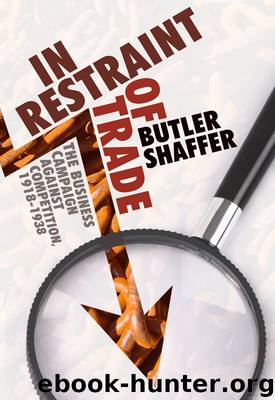In Restraint of Trade by Butler Shaffer

Author:Butler Shaffer [Shaffer, Butler ]
Language: eng
Format: epub
ISBN: 978-1-61016-114-5
Publisher: The Ludwig von Mises Institute
Published: 2011-11-06T16:00:00+00:00
6
The Natural-Resource Industries
Now here, you see, it takes all the running you can do, to keep in the same place. If you want to get somewhere else, you must run at least twice as fast as that.
—The Red Queen, in Through the Looking Glass
The campaign to instill a spirit of intraindustrial cooperation and self-regulation in business was quite intense in the so-called natural-resource industries, particularly petroleum and coal. Because of the significance of these industries to American economic life, the fundamental changes occurring within these industries and the similar problems shared by them, they shall be considered together in this chapter. Because of the inconstancy associated with vigorous and dynamic economic conditions, pressures were exerted by industry members for a more stabilized, equilibrium-based form of competition.
One of the most successful arguments employed by the natural-resource industries for gaining public acceptance of efforts to preserve existing market positions and stabilize prices was that free competition permitted the employment of greater quantities of natural resources that, it was argued, led to “waste.” The solution proposed was a simple one: enact legislation to “conserve” such natural resources in order to assure that future generations would not suffer from the prodigality of today. Conservation became a cause in which its advocates, wrapped in self-approbation, were able to polarize the issue as a choice between planned, intelligent use of scarce resources, on the one hand, and their wanton, reckless, and wasteful squandering, on the other. In popular sentiments toward thrift, many business organizations had a ready-made platform from which to gain support for objectives having to do more with reducing the impact of competition than preserving resources.1 Conservation served, quite well, the broader business purposes of controlling those aggressive competitive practices having the effect of creating lower and unstable prices.
Conservation was, because of its tendencies for controlling production, popular among businessmen. In early 1917, for instance, the U.S. Chamber of Commerce announced the results of a referendum in which 90 percent of the voting commercial organizations favored a proposition to allow firms in the natural-resource industries to enter into FTC-supervised cooperative agreements.2 Such a proposition reflected not only the cartelizing mood of the general business community but the compatibility of such attitudes as conservation and the restraint of competition. Whatever may have been the motives of others who were active in the conservation movement, it cannot be denied that certain business interests found the conservation arguments consistent with their objectives of restricting—and, hence, stabilizing—the quantities of production within various industries. This was especially true in many of the basic natural-resource industries—such as petroleum, coal, and lumber—where the relative ease of turning existing stands of timber into finished lumber, or the unpredictable discovery of large new oil fields, served to make production levels somewhat erratic.3 This irregularity had the effect of causing price levels to fluctuate as well, which prompted industry members to seek methods of bringing production, and with it the general price structure, within more stable and predictable parameters.
Download
This site does not store any files on its server. We only index and link to content provided by other sites. Please contact the content providers to delete copyright contents if any and email us, we'll remove relevant links or contents immediately.
International Integration of the Brazilian Economy by Elias C. Grivoyannis(90685)
The Radium Girls by Kate Moore(11921)
Turbulence by E. J. Noyes(7935)
Nudge - Improving Decisions about Health, Wealth, and Happiness by Thaler Sunstein(7615)
The Black Swan by Nassim Nicholas Taleb(7010)
Rich Dad Poor Dad by Robert T. Kiyosaki(6398)
Pioneering Portfolio Management by David F. Swensen(6226)
Man-made Catastrophes and Risk Information Concealment by Dmitry Chernov & Didier Sornette(5921)
Zero to One by Peter Thiel(5684)
Secrecy World by Jake Bernstein(4640)
Millionaire: The Philanderer, Gambler, and Duelist Who Invented Modern Finance by Janet Gleeson(4374)
The Age of Surveillance Capitalism by Shoshana Zuboff(4209)
Skin in the Game by Nassim Nicholas Taleb(4161)
Bullshit Jobs by David Graeber(4094)
The Money Culture by Michael Lewis(4073)
Skin in the Game: Hidden Asymmetries in Daily Life by Nassim Nicholas Taleb(3929)
The Dhandho Investor by Mohnish Pabrai(3698)
The Wisdom of Finance by Mihir Desai(3649)
Blockchain Basics by Daniel Drescher(3495)
